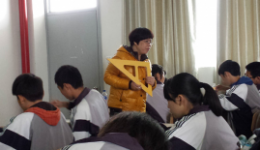初中英语分类复习之介词部分
介词是一种虚词,不能独立充当句子成分,需与动词、形容词和名词搭配,才能在句子中充当成分。介词是用于名词或代词之前,表示词与词之间关系的词类,介词常与动词、形容词和名词搭配表示不同意义。介词短语中介词后接名词、代词或可以替代名词的词(如:动名词v-ing).介词后的代词永远为宾格形式。

一、表示时间的介词
(一)表示时间段的介词
(1)in , after
in +时间段,表示从现在起往后推算一段时间
after +时间段,表示过去某时间往后推算一段时间,如:
He’ll come back in two days. 但点钟用after( after three o’clock)
He left on July 2 and returned after three days.
(2)in , during
表示在一段特指的时间内,可用in 或during
The work was done in / during the holidays.
表示年份、月份、季节用in , 如:in 1999 ,in June , in winter
(3)in last, for the past + 时间段, during
表示在最近一段时间内,句中谓语动词常用现在完成时
I have been in Shanghai in the last few years.
(4)for 表示延续一段时间。
I’ll study in the U.S for two years
I’ve waited for Bingo for half an hour.
(二)表示某一时间的介词

(1)at, on
at 表示某一时刻,on 表示某一天或日期, 如:
at 7:14, on Saturday morning on the night of May2
一天内各段时间表达, 选用正确的介词,请比较:
in the morning
on a winter / snow / cold / morning
at night
on the night of March 7th
in the evening
on Friday evening
(2)before, by
before 表示某一时间之前,而by 表示到某一时间止,句中谓语动词多用完成时态。如::You must get up before six. 你必须六点之前起床。
By the end of last month the boy had got 4 “As”.
到上月底这个男孩已得了4个A.
(3)after , since
after 可以表示过去某一点时间之后,并不延续说话时间,和一般过去连用,而since表示从过去某时间开始的一段时间延续到说话时间, 与现在完时连用 如;
My father lived in Shanghai after liberation .
解放后我父亲住在上海.
Since the end of last year the lady has given five concerts.
自去年年底以来,这位女士开了五十场音乐会
(4)from…to, until / till
from—-to表示从某一点时间到另一点时间的一段时间,而until till 表示某动作或状态延续到某点时间如:
My mother studied in Beijing University from 1960 to 1964.
从1960年到1964年我妈妈在北京大学学习。
My mother entered Beijing University in 1960, and studied there until 1964.
我妈妈1960年进入北京大学,一直学习到1964年。(但“从早到晚”常表达为from morning till night)
(三)不用介词表示时间的词或词组

含this, that, last, next 的表示时间的名词词组,以及某些时间的副词或名词词组前不用介词,如:this year last summer, yesterday , the day after tomorrow 等。
二、表示事物之间位置的介词
(1)at, in
当事物被视作一点,不强调其空间常用介词at, 而表示空间内部用介词in, 如:
We’ll meet at the supermarket 我们在超市见面
I had to stay in the supermarket as it was raining hard
因为下大雨,我只好呆在超市里
*动词arrive 后接at ,表示较小的地方, 如: 车站、村庄等.后接in 表示较大地方,如: 城市,地区等
(2)in, to
in 表示事物在区域范围内的位置,to 表示事物对区域范围之外另一事物的位置,如:
Shanghai is in the east of China. 上海在中国东部
Japan lies to the east of China. 日本位于中国东面。
in front of 表示在前面,一般不在范围内,in the front of 表示在前面.在同一范围内。
(3)after, behind
after 指顺序先后 ,behind 指位置在某事物之后,相对于in front of 而言, 如:
He entered the classroom after the teacher
He hid himself behind the door 他在门后。
(4)on , in
on 表示“在某事物表面上”。如将事物看作空间,表示在其内部,用介词in。
There is a modern painting on the wall .
There is a modern painting on the wall .
(5)from , off 都表示“离开”
(6)above , over, below , under
over , under 表示垂直的上下关系,而above, below 仅表示位置上“高于”或“低于”, 不表示垂直关系。
(7)between, among
between 表示“两个事物之间”, among 表示“三者以上的事物之间”。

三、表示运动方向的介词
(1)into, inside , in 从外到内 如:
He went quickly into / inside the room.
He went quickly into / inside the room.
(2)out of 从里到外,相当于outside, 或从里向外,相当于from
She went out of from the office in a hurry 她匆匆走出办公室.
The boy watched the buses, cars and bikes out from the window .
这男孩透过窗观看外面的公交车、小汽车和自行车。
(3)on 在……表面,onto 到……上
A boat is on the river. 一条小船在河上。
He jumped onto a tree. 他跳上一棵树
(4)across 穿过一平面、through 穿过一空间
The boy kicked the ball hard and it moved across the grass.
这男孩用力踢球,球飞过草地。
The train moved fast through the tunnel. 火车飞驶隧道。
(5)The train moved fast through the tunnel. 火车飞驶隧道。
She walked to the bank 她步行到银行去
She swam towards the shore 她朝岸边游去。

四、常用介词用法比较
(1)as , like
as 表示“作为”强调身份,like (介词)表示“像”
As a teacher, he cares for these children.
Like a teacher, he cares for these children.
(2)with , in
with 表示“外貌特征或附带的东西” ,“ 用……作工具”
in 表示”衣着” ”用某语言”, 在固定搭配中也可用in
A man with dark glasses wanted to buy drinks.
A man in black wanted to buy drinks.
The boy is learning to write in pencil / with a pencil.
He retold the text in English.
(3)for , to
for表示“为了.”
To 表示动作对象, “对, 向.” 如:
He would do anything for his motherland.
Did you mention this to my father?
你对我父亲提起过这件事吗?
for 表示“就某情况而说 ”, to 表示一“对某对象而言”如:
It’s quite warm today for February.就二月的天气,今天够暖和的。
What he told you just now was not new to me
他刚才对你所说的话对我并不新鲜
for 表示“目的,用途”。与go, come 动词连用,
(4)except , besides
except 表示“从总体中排除一部分”, 与bat 同义, besides 表示“除了一部分还有另一部分”
We all failed except him. 我们都失败了,但他没有。
He speaks German besides French.他懂法外还会讲英语。
(5)注意成对介词的用法:
get into (out of ) the car, get on (off) the bus, jump onto (off) the platform, out of
(6)介词和名词动词等有不少固定搭配和习惯用法:
to one’s surprise / joy, in charge of , instead of, in bed (hospital), in trouble, in a hurry, in surprise, with a smile, with one voice, according to, at once, on time, in time, in all, at home, (school, work), at last, at least, in the end, by the way, for example, at the same time, at the same speed, on one’s way (to), in the sun, on the football team, in line, with the help of, teacheray.com in red / green … put on, look for, look after, run after, send for, enter for, pay for, show…around, listen to, arrive in / at, get to, agree with, succeed in, think of (about), wait for,….
(7)表示加减乘除,分别用介词plus, minus, times 和动词过去分词divided + by

五、复习时需要注意的要点
(1) 介词一般放在名词之前,但它后面的介词宾语是疑问代词、疑问副词或者关系代词时,这些词提到了前面而只剩下介词在后了。
(2) 介词和动词、形容词、名词等常常构成固定搭配,也就是说,在这些词的后面常常要求用一定的介词。这一点在学习时要特别注意。如:
a.动词+介词:laugh at, wait for
b.形容词、过去分词+介词:be good at, be prond of
c. 名词+介词:pay a visit to , the key to
想学好初中英语,同学们得下功夫,同时还要经常自我反思,提高效率是关键。一本好的辅导书对学好英语,提高考试分数是非常有帮助的。我把我写的初中英语自诊断这本书推荐给同学们。这本书的最大特点就是所有的题都配有视频。在做题过程中遇到问题,扫题旁的二维码即可查看该题的视频讲解。这样非常有针对性的进行学习和查漏补缺,及时把问题解决掉。
初中英语自诊断这本书的定位是教学服务,我在线提供伴读式的答疑服务。任何一道题我都会竭尽全力的帮您孩子学到手,学透彻。在做题或看视频的过程中遇到问题,随时可在微信公众号teacheray留言,您的问题我都会回复,帮您更有效的学习。而其他的辅导书是绝对不可能提供这样的答疑服务的,他们就是卖一本书赚一份前,不会为您孩子的学习负责和服务。请您相信我,您孩子的提问与我的答疑过程,对更深入理解单词与词汇含义,语法用法,理解句子含义等等都是非常有帮助的。
众所周知的是,很多孩子英语学不好是因为基础差,课下学习中遇到了问题自己解决不了,导致问题像滚雪球一样,越积累越多。初中英语自诊断这本书提供了这样的便利,每道题的旁边都有视频解析,遇到问题就可以扫码看视频,通过视频我会带着您一步步分析,找到解题的切入点和绊住自己的地方,提高学习效率。英语单词和短语是学好英语的基石,常考常见的要记要背过,没有词汇量的有力支撑,中考是不可能考出好分数的,而且还会影响到高中的学习。初中阶段的核心词汇与短语,我在初中英语自诊断书中都已经为同学们整理好了,这可是我十多年教学经验的积累。
这些单词和后面的阅读理解和完形填空题是一脉相承的,在阅读理解与完形填空的视频解析中,我会带着同学们不断复习巩固。从单词短语到阅读理解,在从阅读理解到单词短语,不断系统循环起来,帮同学们把知识夯实牢固。安颖老师新书初中英语自诊断开始发售,这本书最大的特点是,任何一道题都有视频讲解过程,哪道题学习中有问题,扫题旁二维码即可看对应的视频讲解,帮您把问题快速解决掉。
学习效率更高,考试分数更高。欢迎添加安颖老师微信公众号teacheray咨询购买。
原创/安颖/北京西城英语教师
未经授权不得转载。版权所有:安颖英语






